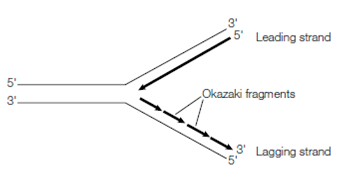Okazaki fragments:
Double-stranded DNA is antiparallel one strand runs 5' → 3' and the complementary strand runs 3' → 5'. As the unique double-stranded DNA opens up at a replication fork new DNA is build against every template strand. Superficially, thus, one might expect new DNA to be made 5' → 3' for one daughter strand and 3' → 5' for the other daughter strand. Moreover, all DNA polymerases build DNA only in the 5' → 3' direction and it never in the 3' → 5' direction. What in fact happens is which on the template strand with 3' → 5' orientation; the new DNA is made in a continuous piece in the correct 5' → 3' direction. That new DNA is known as the leading thread. On the another sample strand which has a 5' → 3' orientation, DNA polymerase synthesizes short pieces of new DNA about 1000-2000 nucleotides long in the 5' → 3' direction and joins these pieces mutually. The small fragments are known Okazaki fragments after their discoverer. The new DNA strand that is made through this discontinuous method is known as the lagging strand.

figure: Synthesis of DNA at a replication fork. As the parental DNA (thin line) opens up, each of the two parental strands acts as a template for new DNA synthesis (thick lines). The leading strand is synthesized continuously but the lagging strand is synthesized as short (Okazaki) DNA fragments that are then joined together.